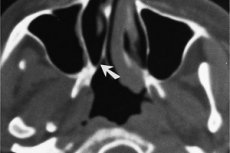Medical expert of the article
New publications
Restoration of choanal atresia
Last reviewed: 08.07.2025

All iLive content is medically reviewed or fact checked to ensure as much factual accuracy as possible.
We have strict sourcing guidelines and only link to reputable media sites, academic research institutions and, whenever possible, medically peer reviewed studies. Note that the numbers in parentheses ([1], [2], etc.) are clickable links to these studies.
If you feel that any of our content is inaccurate, out-of-date, or otherwise questionable, please select it and press Ctrl + Enter.

Congenital choanal atresia occurs when the mesenchymal tissue that forms a membrane around the choanal openings fails to fully or partially dissolve during the embryonic period. In one in 7,000 cases, a newborn baby cannot breathe through its nose. The defect is diagnosed at birth when both openings are blocked. If one opening is blocked, the diagnosis may be made later, usually when mucus leaks from only one nostril. Choanal restoration requires surgical intervention. In this case, a CT scan is performed to confirm the diagnosis.
Overview of types of surgery
The operation is performed under general anesthesia. The surgeon can perform it in two ways: transnasally (inserting instruments through the nostrils) or transpalatally (making an incision in the palate), taking into account the anatomy of the nasal passages. The operation is performed through the nose if the passages are blocked by tissue, and an incision is made in the palate if the passages are blocked by bone. In both cases, choanal openings are formed using nasal stents, which are removed after 6 months.
Postoperative period
After the operation, the baby can breathe normally and can be bottle-fed. The newborn is kept in the hospital for observation for several days, older children who only had one nasal passage restored are discharged a little earlier. The doctor will explain in detail how to care for the nasal passages so that the baby can breathe freely through the stents until they are removed. One should also not forget about possible complications (inflammation or bleeding), if observed, you should immediately go to the hospital. After removing the nasal stents, the doctor will check the airways with an endoscope.
Why this needs to be done
During the operation, the nasal passages are opened so that the baby can breathe freely in the future. Newborns in the first weeks of life can breathe only through the nose (excluding crying).
Operation efficiency
Usually the surgery gives an excellent result. In most cases only one surgical intervention is required, but in rare cases the procedure is repeated (when the nasal passages are closed again).
 [ 1 ], [ 2 ], [ 3 ], [ 4 ], [ 5 ], [ 6 ]
[ 1 ], [ 2 ], [ 3 ], [ 4 ], [ 5 ], [ 6 ]
Risk factors
The main risk is the need for a second operation if the nasal passages become blocked again. Overall, there is a small risk of complications such as bleeding or inflammation. Any surgery using general anesthesia has a small risk. Contact your doctor immediately if your child has bleeding, a high fever, pus, or cannot breathe through the nose because the stents are clogged. Rarely, the nasal passages and skull are injured during surgery.
Things to think about
The operation can be postponed for 2-3 years if one of the channels is blocked. Transnasal intervention is faster than transpalatal, but it has a higher risk of closure of the nasal passages in the future.

